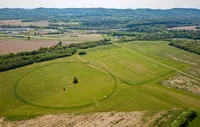Explore UNESCO World Heritage newest sites & stories

The Hopewell Ceremonial Earthworks in Ohio recently were inscribed on the UNESCO World Heritage List. The site encompasses eight monumental earthworks that were built 2,000 years ago by Indigenous Native Americans known as the Hopewell Culture.
The site involves huge earthen squares, circles and octagons that are geometrically precise and align perfectly with the cycles of the sun and moon. They are among the finest examples of earthen architecture in the world, and part of the significance of the Hopewell Ceremonial Earthworks arises from the fact that their architects did not live in cities and were not subjects of authoritarian rulers. Nonetheless, they cooperated to build earthworks of enormous scale and geometrical precision, and the site includes artifacts crafted from material not typically found in Ohio — like obsidian from the Rocky Mountains and seashells from the Gulf of Mexico.
The Hopewell Ceremonial Earthworks are a unique and historic marvel, and for World Heritage Day we invite you to learn more about it and other stories featured below of the 2023 World Heritage additions and more UNESCO World Heritage sites on Google Arts & Culture.
The Hopewell Ceremonial Earthworks are a series of 8 monumental earthen enclosures built in southern Ohio by Indigenous American Indians 2,000 years ago. Together these eight distinct earthworks, dispersed along the main southward flowing tributaries of the Ohio River, share a geometrical precision and alignments to the cycles of the sun and moon that reflect an unparalleled achievement of human creative genius.
Hopewell Ceremonial Earthworks, USA

Talayotic Menorca encompasses the main prehistoric archaeological sites of Menorca, along with the landscapes that surround them. Located in the western Mediterranean, this Spanish island has an area of only 700km2, however more than 1,500 prehistoric sites can be found here.
Talayotic Menorca, Spain

Modernist Kaunas is situated in central Lithuania, at the confluence of two major rivers. The property consists of two areas – Naujamiestis and Žaliakalnis – both of which possess several distinctive components in terms of historical significance, architecture, and urban planning.
Modernist Kaunas, Lithuania

Tyne Cot Cemetery and Memorial to the Missing, Passendale is the Commonwealth War Graves Commission’s largest cemetery, with almost 12,000 tombstones. The memorial forms the north-eastern boundary of the cemetery and bears the names of almost 35,000 soldiers from the United Kingdom and New Zealand whose graves are not known.
Funerary & memory sites, Flanders Fields, Belgium

The five ring-shaped fortresses represent outstanding examples and technological mastery of military architecture. They were strategically positioned near important land and sea routes, and used the natural features of the surrounding landscape for defensive purposes.
Viking-Age Ring Fortresses, Denmark

Located in the heart of the Old Town of Erfurt, in the central-German state of Thuringia, the Jewish-Medieval Heritage of Erfurt comprises three monuments: the Old Synagogue, the Mikveh and the Stone House. It is an early and rare testimony to Jewish religious and secular architecture from the Middle Ages in Central Europe.
Jewish-Medieval Heritage of Erfurt, Germany







